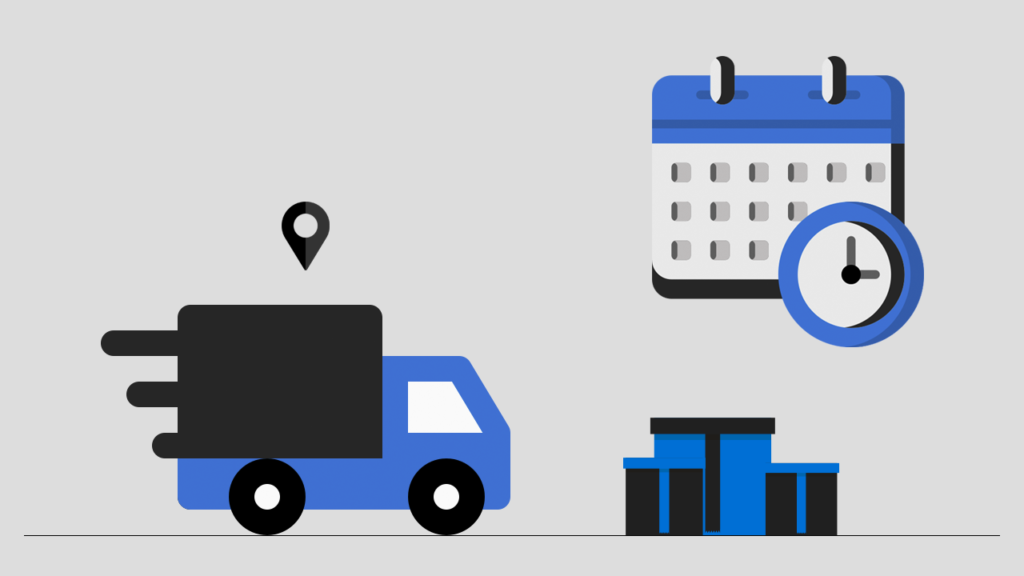What Does Estimated Delivery Mean? Identifying the Cracking Code
“Estimated delivery” is the approximate date when a package or order is expected to be delivered.
In today’s age of online shopping, the idea of “estimated delivery” is crucial for both customer satisfaction and business operations.
Estimated delivery is the expected date or time frame for the arrival of a package or order at its destination. This prediction significantly influences the expectations of consumers and businesses in the realm of shipping and online shopping.
Who Sets the Estimates?

The responsibility for establishing estimated delivery dates is a collaborative effort involving several key players in the e-commerce and shipping ecosystem:
Retailers: E-commerce companies typically play a central role in setting estimated delivery dates. They consider various factors such as inventory levels, shipping options, and historical delivery data to provide customers with delivery estimates during checkout.
Shipping Companies: Shipping companies transport the packages from the seller to the buyer and are integral to the process.
They collaborate closely with retailers to ensure timely and accurate deliveries, considering factors like shipping speed, distance, and delivery routes.
Courier Services: Courier services, often subcontracted by shipping companies, play a significant role in the “last mile” delivery – the final leg of the shipping journey from a local distribution center to the customer’s doorstep.
They help ensure that the estimated delivery date is met.
Technology and Data: Advanced tracking and logistics technology, powered by data analytics, are used to provide accurate delivery estimates. This technology considers real-time data, weather conditions, traffic patterns, and historical delivery performance.
Factors Affecting Estimated Delivery:
Estimated delivery times are influenced by a multitude of variables that collectively shape when a package will reach its destination. These variables encompass a wide range of factors, including:
Shipping Method:
- Standard Shipping: This method typically balances cost and speed, resulting in a moderate estimated delivery time.
- Expedited or Express Shipping: Faster shipping options come with shorter estimated delivery times but are usually more expensive.
- Same-Day or Next-Day Delivery: These services provide the quickest estimated delivery times, often within 24 hours, and are ideal for urgent shipments.
Destination:
- Domestic vs. International: Domestic shipping generally involves shorter estimated delivery times compared to international shipping, which can vary significantly depending on customs procedures and distance.
- Remote Areas: Deliveries to remote or less accessible locations may have longer estimated delivery times due to logistical challenges.
Order Processing Time:
The time it takes for a business to process and prepare an order before it’s handed over to the shipping company can influence the estimated delivery date. The retailer often specifies this processing time during the checkout process.
Shipping Distance:
The distance between the sender and recipient’s locations is a crucial factor. Greater shipping distances usually lead to extended estimated delivery times.
Shipping Carrier:
Different shipping carriers (e.g., UPS, FedEx, USPS, DHL) have their own networks and standards for delivery. Each carrier’s efficiency and speed can affect the estimated delivery time.
Seasonal and Peak Periods:
During holidays, promotions, or peak shopping seasons like Black Friday or Christmas, estimated delivery times can be extended because of higher demand and possible shipping delays.
Weather and Natural Disasters:
Adverse weather conditions, natural disasters, or other unexpected events can disrupt shipping routes and cause delays, affecting the accuracy of estimated delivery times.
- Weather Conditions: Unfavorable weather conditions like heavy rain, snow, or strong winds can disrupt transportation and cause delays in delivery processes. For example, a blizzard may result in delays of 1-2 days, while a severe thunderstorm could set back deliveries by 4-6 hours.
- Natural Disasters: Events like hurricanes, earthquakes, or wildfires can have a more substantial impact.
In the aftermath of a hurricane, it’s not uncommon for delivery delays to extend up to a week or more as infrastructure and transportation routes may be severely affected.
- Ultimately, Mild weather-related delays may result in an additional 1-2 days, whereas major natural disasters can lead to delivery delays ranging from several days to weeks.
Customs Clearance (for International Shipments):
When shipping internationally, customs clearance can significantly impact delivery times. Delays may occur if customs processes are slow or if additional documentation is required.
Package Size and Weight:
- Heavier or oversized packages may require special handling, resulting in longer estimated delivery times compared to standard-sized shipments.
- A small, lightweight package may have an estimated delivery date of 2-3 days, while a large, heavy package might have an estimated delivery date of 5-7 days due to the additional handling and transportation considerations.
Service Level Agreements (SLAs):
Businesses may offer service-level agreements with guaranteed delivery times. These SLAs can lead to more accurate estimated delivery times when the guarantee is met.
Challenges in Meeting Estimated Delivery Times:
Meeting estimated delivery times is a significant challenge for businesses, particularly in the context of e-commerce and shipping. Several factors can create hurdles in achieving timely deliveries:
Logistics Complexity: The modern supply chain can be highly complex, with multiple steps, hubs, and various transportation methods involved. Any disruption in this chain can lead to delays.
Volume and Peak Seasons: During busy periods such as holidays and sales events, businesses often experience a surge in orders. This increased volume can strain logistical operations and impact delivery times.
Geographic Diversity: Delivering packages across vast geographic areas, especially in international shipping, can be challenging. Different regions may have varying infrastructure, customs processes, and transportation networks.
Weather and Natural Events: Adverse weather conditions, natural disasters, or other unexpected events can disrupt shipping routes, causing unexpected delays.
Last-Mile Challenges: The “last mile” of delivery, from the local distribution center to the customer’s doorstep, can be particularly challenging due to factors like traffic, address accuracy, and delivery windows.
Advice for Managing Customer Expectations:
To effectively manage customer expectations and mitigate the challenges of meeting estimated delivery times, businesses can consider the following strategies:
Transparency: Be transparent about delivery times. Provide accurate estimated delivery dates during the ordering process and set realistic expectations.
Communication: To minimize uncertainty, keep customers informed about their order’s progress by sending timely updates and notifications, which should include tracking information.
Quality Control: Ensure that your products are well-packaged and labeled accurately. Accurate labeling can prevent shipping errors and delays.
Shipping Options: Offer various shipping options, including expedited services for those willing to pay extra for faster delivery.
Tracking and Notifications: Provide reliable tracking tools and real-time notifications to inform customers about their packages’ status.
Dealing with Delivery Delays:
Delivery delays can be frustrating, but they are a common issue in the shipping and logistics industry. Here’s guidance on what customers can do when their deliveries are not on time:
Check Tracking Information:
Start by checking the tracking information for your package. The tracking details often provide insights into the cause of the delay. Look for notifications or messages from the shipping carrier.
Contact the Carrier:
If you notice a significant delay and the tracking information doesn’t provide a clear reason, contact the customer service of the shipping carrier. They can give you more information about what’s causing the delay and offer potential solutions.
Review Retailer’s Policies:
If you made a purchase through an online store, review their policies regarding delayed deliveries. Some retailers have specific procedures or guarantees for handling delays. You may be eligible for compensation or other remedies.
Consider External Factors:
Stay alert to external factors that can lead to delays, such as adverse weather conditions or holiday-related disruptions. These challenges are frequently beyond the carrier’s control and may demand additional time for resolution.
Communication:
If you have specific delivery requirements or need to reschedule due to a delay, communicate with the shipping carrier to decide. They may be able to accommodate your needs or provide an updated delivery estimate.
Patience and Understanding:
While delays can be inconvenient, remaining patient and understanding is essential. Carriers and retailers are typically working to resolve issues and deliver your package as quickly as possible.
File a Claim (If Necessary):
In cases of prolonged or severe delays, you may need to file a claim with the shipping carrier or retailer. You might be entitled to compensation or a resolution if you paid for guaranteed delivery services. Follow the carrier’s or retailer’s specific claim process.
Review Your Rights:
Get acquainted with your consumer rights, which can differ based on your location and the terms and conditions set by the retailer or carrier. Knowing your rights empowers you to advocate for a fair resolution when needed.
Escalate if Needed:
If the delay is excessively long, and you aren’t receiving satisfactory assistance, consider escalating the issue. Contact the carrier’s higher-level customer service or the retailer’s management to seek a resolution.
Leave Feedback:
After resolving your issue, consider providing feedback to the carrier and retailer. This feedback can help them improve their processes and prevent similar delays in the future.
The Role of Technology in Improving Estimated Delivery Accuracy:

Technology and data analytics have revolutionized the shipping and logistics industry, significantly enhancing the accuracy of estimated delivery times. Here’s how these innovations are improving the accuracy of estimated delivery:
Data Analytics and Predictive Modeling:
Data analytics allows companies to leverage historical shipping data, weather patterns, traffic data, and other relevant information to create predictive models.
These models can accurately estimate delivery times, accounting for various variables that can affect deliveries.
Real-Time Tracking and Monitoring:
Real-time tracking tools and GPS technology enable customers and businesses to monitor the exact location of their packages during transit.
This keeps customers informed and allows businesses to make real-time adjustments to routes and schedules to minimize delays.
Route Optimization:
Technology plays a crucial role in optimizing delivery routes by factoring in elements such as traffic patterns, road closures, and weather conditions.
Advanced algorithms can dynamically adapt routes to guarantee the quickest and most efficient delivery.
Machine Learning and AI:
Machine learning and artificial intelligence algorithms can continuously improve estimated delivery accuracy by analyzing vast amounts of data. They adapt to changing conditions and optimize routes in real time, reducing the likelihood of delays.
Automation and Robotics:
Automated sorting facilities and conveyor systems expedite the handling of packages, reducing processing times. Robotics in warehouses and distribution centers help ensure accurate and timely order fulfillment.
Drones and Autonomous Vehicles:
Companies are exploring innovations like delivery drones and autonomous delivery vehicles to expedite last-mile deliveries. These technologies can navigate traffic more efficiently and reduce the likelihood of delays.
Customer-Facing Tracking Apps:
Shipping carriers and e-commerce companies provide customer-facing tracking apps that enable users to check the status of their packages in real-time. These apps offer notifications, estimated delivery times, and other helpful features for customers.
FAQs
What does “estimated delivery” mean?
“Estimated delivery” refers to the anticipated date or time frame when a package or shipment is expected to be delivered to the recipient.
Is the estimated delivery date a guaranteed delivery date?
No, the estimated delivery date is not always a guaranteed delivery date; it represents an approximation and may be subject to changes.
Why is there a range for the estimated delivery date?
Ranges are provided to account for potential variations in the delivery process, such as transit time and local delivery conditions.
What factors influence the estimated delivery date?
Factors include the shipping method chosen, the destination, the shipping company, and any potential delays in the delivery process.
Can the estimated delivery date change during transit?
Yes, the estimated delivery date can change if unexpected delays occur, like severe weather or transportation issues.
Is the estimated delivery date the same as the shipping date?
No, the estimated delivery date is the expected date of arrival, while the shipping date is when the package was sent out.
Is the estimated delivery date always accurate?
The estimate is based on available information but may not always be accurate due to unforeseen circumstances.
What should I do if my package doesn’t arrive on the estimated delivery date?
If your package doesn’t arrive on the estimated delivery date, wait a little longer, check tracking information, and contact the carrier or seller if necessary.
Is the estimated delivery date the same for all carriers and shipping services?
No, different carriers and shipping services may provide different estimated delivery dates based on their specific processes.
Can I choose the delivery date when I order something?
Some shipping services and sellers offer the option to select a specific delivery date, but it may come with additional costs.
Does international shipping impact the estimated delivery date?
Yes, international shipping can involve additional variables, such as customs clearance, which can affect the estimated delivery date.
Conclusion
In summary, “estimated delivery” is the anticipated date or time frame when a package or order is expected to reach its destination. It plays a pivotal role in the world of e-commerce and shipping, impacting both consumers and businesses.
In this age of e-commerce, the relationship between consumers and businesses is intricately tied to the concept of estimated delivery.
To enhance this relationship, consumers should stay informed, realistic, and patient, while businesses should strive for transparency, reliability, and continuous improvement.
The future of estimated delivery promises even more precision and efficiency through evolving technological innovations, ultimately benefiting both sides of the transaction.







